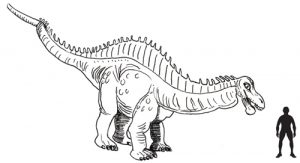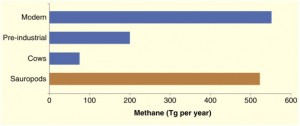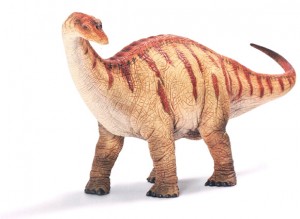Study Suggests Sauropods May have Contributed to Global Warming in the Mesozoic
A team of British scientists have put the wind up palaeontologists by creating a mathematical model that attempts to predict the impact on global warming that the gases produced by large plant-eating dinosaurs might have had. The researchers, David Wilkinson (Liverpool John Moores University), Euan Nisbet (University of London) and Graeme Ruxton (University of Glasgow) have calculated that sauropods could have produced 520 million tonnes of methane each year. At this level of output, the methane would have probably had a significant impact on the climate of the Mesozoic, contributing to global warming.
Scientists Calculate that Sauropods Contributed to Mesozoic “Global Warming”
Picture credit: Everything Dinosaur
Herbivorous mega fauna of the Mesozoic, would have had large quantities of microbes inside their enormous digestive tracts. These microbial agents would have had a symbiotic relationship with their reptilian hosts, with the micro-organisms acting as methanogenic symbionts for the fermentation of the plant material ingested by mega herbivores such as the Sauropoda.
Methane Produced by Dinosaurs
Sauropods are the long-necked dinosaurs. Well-known sauropods include Diplodocus, Brachiosaurus and Apatosaurus, which was formerly known as Brontosaurus*. Such creatures had a small head, a long neck, a massive, elephantine body and long tails. The sauropods evolved into a myriad of forms, some of which represent the largest land animals known to science with body weights in excess of 20,000 kilogrammes. The scientists published their research in the scientific journal “Current Biology”, using studies of Apatosaurus bones found in the western United States. The team made a number of assumptions regarding the global population of sauropods in the Late Jurassic and based on these calculations they estimate that these large herbivores and the microbes that lived inside their massive digestive tracts would have produced more than half a billion tonnes of methane per annum. Such large scale methane production would have had an impact on the gaseous content of the atmosphere and with methane being a significant “greenhouse gas”, it is likely that the Mesozoic climate was influenced by this gas production.
Herbivorous Dinosaurs
Methane would have also been produced by other herbivorous dinosaurs, most notably members of the Thyreophora (shield bearers), such as Stegosaurus. However, the huge sauropods would have contributed the most and according to the British researchers their combined wind production, the gas created and emitted as a result of microbial action breaking down the plant material the creatures consumed, would have been many times what cows produce today.
Ruminants such as cows are being blamed by many global climate researchers for making a large contribution to the production of methane. Methane is a more harmful “greenhouse gas” than carbon dioxide. Methane in the upper atmosphere would trap heat very effectively and therefore this would make a significant contribution to the heating up of the planet. However, cows tend to be a lot smaller than sauropods and the research team calculated the potential density of these large sauropods during the Late Jurassic and as a result, the long-necked dinosaurs could be regarded as “super-contributors” to the organic methane output of the Mesozoic.
Scientists have long regarded the Late Jurassic as a time when the Earth’s climate was much more humid and warmer than today. Very little evidence has been put forward to suggest permanent icecaps at the poles during the Late Jurassic. Although there was very probably ice and snow at the poles (both North and South – very high latitudes and very low latitudes), this was likely to be seasonal. Plant fossils discovered in Alaska and Siberia suggest that even land close to the poles had relatively warm climates in the Late Jurassic (155 million to 144 million years ago). The British research team proposed that there would have been a greater amount of land area available to the Jurassic browsers and grazers than the modern, mammalian mega herbivores that produce methane today. This and calculations of herbivore density suggest that the dinosaurs such as Apatosaurus would have contributed more than five times the amount of methane than ruminants such as cows do today.
Commenting on the study, Dr Wilkinson of Liverpool John Moores University, at the department of natural science and psychology stated that it was not the dinosaurs that produced the methane, it would have been the microbes that lived inside their guts that were responsible for the gas production.
Dr Wilkinson went onto add:
“We used modern zoology to make informed guesses and estimated methane levels of dinosaurs. This research does not propose that climate changed was responsible for the wiping out of the dinosaurs – in fact warm conditions would have been a benefit.”
Comparing the Methane Production from a Number of Sources
Table credit: Current Biology/Wilkinson et al.
Warm Conditions Suited Reptiles
The warm conditions would have suited the reptilian dinosaurs, especially if they were cold-blooded (ectothermic) animals. This may provide one of the reasons for the success of the Dinosauria Order, which palaeontologists suggest may have contained more than two thousand genera. Today’s average global temperature is approximately 14 degrees Celsius, although scientists predict that “greenhouse gases” in the Earth’s atmosphere may increase global temperatures by as much as three degrees over the next fifty years or so. The global temperature on Earth during the Late Jurassic, the time in Earth’s history that was used as the basis for this study, is estimated to be at least ten degrees higher than average temperatures today.
Ironically, after the demise of the Dinosauria some sixty-six million years ago, global temperatures are believed to have rocketed reaching a peak of an average of twenty-eight degrees Celsius by the mid Paleogene geological period.
The study team used a variety of assumptions to calculate the methane production of sauropods, their mathematical model involved parameters such as potential sauropod density, the amount of land area that was suitable for mega herbivore habitat and the average size of sauropods, specifically the Apatosaurus genus and species such as A. louisae. This data was then compared to known data on the methane production from modern day ruminants.
Study Based on the Sauropod Apatosaurus louisae
Methane production today, is estimated to be around five hundred million tonnes, or to put it another way, equivalent to the estimated output of the Sauropoda in the Late Jurassic. Methane is being added to the atmosphere from a variety of sources such as the digestion of plant material by wild animals and by human enterprises such as dairying and extensive meat production.
Dr Wilkinson did state that there were other sources of methane during the Mesozoic he commented that the dinosaurs were not the sole producers of methane at the time. Overall, the British team estimate that the atmospheric methane levels in the Jurassic were much higher than they are today.
One thing is for certain, if you were to visit the area that was to become the Morrison Formation of the western United States during the Late Jurassic, you would be well-advised to stay upwind of any herd of sauropods you came across as the gas these animals would have produced would have been most unpleasant.
Please Note *Brontosaurus is now regarded as a valid genus.
The scientific paper: “Could methane produced by sauropod dinosaurs have helped drive Mesozoic climate warmth?” by David M. Wilkinson, Euan G. Nisbet and Graeme D. Ruxton published in Current Biology.
For models and replicas of sauropods and other dinosaurs: CollectA Deluxe Prehistoric Animal Scale Models.









Leave A Comment